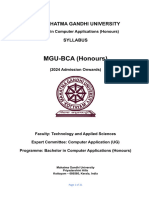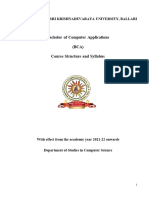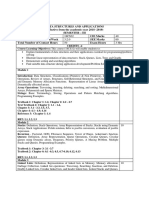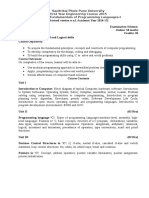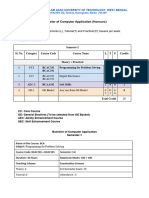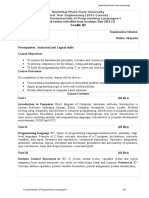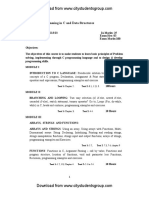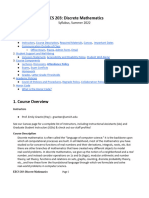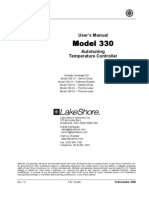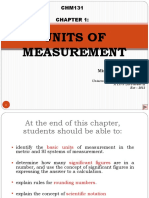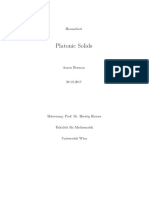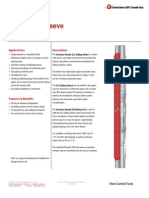0 ratings0% found this document useful (0 votes)
4 views18CPS13-23 syllabus
18CPS13-23 syllabus
Uploaded by
vishalcv.reachmeSyllabus
Copyright:
© All Rights Reserved
Available Formats
Download as PDF, TXT or read online from Scribd
18CPS13-23 syllabus
18CPS13-23 syllabus
Uploaded by
vishalcv.reachme0 ratings0% found this document useful (0 votes)
4 views2 pagesSyllabus
Copyright
© © All Rights Reserved
Available Formats
PDF, TXT or read online from Scribd
Share this document
Did you find this document useful?
Is this content inappropriate?
Syllabus
Copyright:
© All Rights Reserved
Available Formats
Download as PDF, TXT or read online from Scribd
Download as pdf or txt
0 ratings0% found this document useful (0 votes)
4 views2 pages18CPS13-23 syllabus
18CPS13-23 syllabus
Uploaded by
vishalcv.reachmeSyllabus
Copyright:
© All Rights Reserved
Available Formats
Download as PDF, TXT or read online from Scribd
Download as pdf or txt
You are on page 1of 2
C PROGRAMMING FOR PROBLEM SOLVING
(Effective from the academic year 2018 -2019)
SEMESTER – I/II
Subject Code 18CPS13/23 CIE Marks 40
Number of Contact Hours/Week 2:2:0 SEE Marks 60
Total Number of Contact Hours 40 Exam Hours 3 Hrs
CREDITS –3
Module 1 Contact
Hours
Introduction to computer Hardware and software: Computer generations, computer 08
types, bits, bytes and words, CPU, Primary memory, Secondary memory, ports and
connections, input devices, output devices, Computers in a network, Network hardware,
Software basics, software types.
Overview of C: Basic structure of C program, executing a C program. Constant, variable and
data types, Operators and expressions,
Reference 1: Chapter 1, Chapter 2 (2.2, 2.3)
Text book 1: Ch 1, 2 and 3
Module 2
Managing Input and output operations. Conditional Branching and Loops.Example programs, 08
Finding roots of a quadratic equation, computation of binomial coefficients, plotting of
Pascals triangle.
Text book 1: 4, 5 and 6
Module 3
Arrays: Arrays (1-D, 2-D), Character arrays and Strings, Basic Algorithms: Searching and 08
Sorting Algorithms (Linear search, Binary search, Bubble sort and Selection sort).
Text book 1: Ch 5, 6, 7 (7.1 to 7.6) and 8 (8.1 to 8.8)
Module 4
User Defined Functions and Recursion. 08
Example programs, Finding Factorial of a positive integers and Fibonacci series.
Text book 1: Ch 9 (9.1 to 9.18)
Module 5
Structure and Pointers, Preprocessor Directives 08
Text book 1: Ch 10 (10.1 to 10.9) and 11(11.1 to 11. 6 and 11.16)
Course Outcomes: The student will be able to :
• Illustrate simple algorithms from the different domains such as mathematics, physics, etc.
• Construct a programming solution to the given problem using C.
• Identify and correct the syntax and logical errors in C programs.
• Modularize the given problem using functions and structures.
Question Paper Pattern:
• The question paper will have ten questions.
• Each full Question consisting of 20 marks
• There will be 2 full questions (with a maximum of four sub questions) from each module.
• Each full question will have sub questions covering all the topics under a module.
• The students will have to answer 5 full questions, selecting one full question from each module.
Textbooks:
1. E. Balaguruswamy, Programming in ANSI C, 7th Edition, Tata McGraw-Hill
2. Brian W. Kernighan and Dennis M. Ritchie, The C Programming Language, Prentice Hall of
India.
Reference Books:
1. Sumitabha Das, Computer Fundamentals & C Programming, Mc Graw Hill Education.
2. Gary J Bronson, ANSI C Programming, 4th Edition, Ceneage Learning.
3. Vikas Gupta: Computer Concepts and C Programming, Dreamtech Press 2013.
4. R S Bichkar, Programming with C, University Press, 2012.
5. V Rajaraman: Computer Programming in C, PHI, 2013.
6. Basavaraj S. Anami, Shanmukhappa A Angadi, Sunilkumar S. Manvi, Computer Concepts and C
Programming: A Holistic Approach to Learning C, Seond edition, PHI India, 2010.
You might also like
- Cambridge Secondary Checkpoint - Mathematics (1112) April 2020 Paper 2 QuestionDocument16 pagesCambridge Secondary Checkpoint - Mathematics (1112) April 2020 Paper 2 Questionevelyne serafee86% (7)
- MCV4U CH 8 Nelson SolutionsDocument29 pagesMCV4U CH 8 Nelson SolutionsStephanieNo ratings yet
- Programming For Problem Solving1'Document2 pagesProgramming For Problem Solving1'Ankush0% (1)
- Métodos numéricos aplicados a Ingeniería: Casos de estudio usando MATLABFrom EverandMétodos numéricos aplicados a Ingeniería: Casos de estudio usando MATLABRating: 5 out of 5 stars5/5 (1)
- COS1077B C ProgrammingDocument48 pagesCOS1077B C ProgrammingmahendrasuryavanshiNo ratings yet
- 2019-20-CPS Syllabus Theory LabDocument4 pages2019-20-CPS Syllabus Theory LabRamesh GNo ratings yet
- COS1082B Lab On C ProgrammingDocument47 pagesCOS1082B Lab On C ProgrammingmahendrasuryavanshiNo ratings yet
- PPS V2 Common To AllDocument5 pagesPPS V2 Common To AllkottargivijaylaxmiNo ratings yet
- BSC 2 Sem C Note 2023-24Document74 pagesBSC 2 Sem C Note 2023-24rajanikanthNo ratings yet
- PIC Syllabus TheoryyyDocument3 pagesPIC Syllabus TheoryyyAnkit PandeyNo ratings yet
- Programming in C and Data StricturesDocument3 pagesProgramming in C and Data StricturesAnuNo ratings yet
- EContent_7_2024_12_14_23_51_16_SYLLABUSpdf__2024_08_23_15_20_22Document7 pagesEContent_7_2024_12_14_23_51_16_SYLLABUSpdf__2024_08_23_15_20_22karthiknarlapuramNo ratings yet
- Programming Language-I PDFDocument3 pagesProgramming Language-I PDFanku86No ratings yet
- Yr 1Document26 pagesYr 1ashismahato997No ratings yet
- Cse 6TH Sem SyllabusDocument9 pagesCse 6TH Sem SyllabusCHETHAN NVNo ratings yet
- VTU S6 SyllabusDocument37 pagesVTU S6 SyllabusAppu ManjeshNo ratings yet
- 5 Sen SyllabusDocument13 pages5 Sen SyllabusAman SinghNo ratings yet
- Syllabus For BCSDocument15 pagesSyllabus For BCSmdfaizansari065No ratings yet
- BCA SyllabusDocument21 pagesBCA Syllabusjayapadmanabhan263No ratings yet
- FOP SyllabusDocument5 pagesFOP SyllabuskhushbuceNo ratings yet
- M Tech Syllabus Without LabsDocument53 pagesM Tech Syllabus Without LabsRajesh KannaNo ratings yet
- Bca-14 12 2021Document14 pagesBca-14 12 2021Uma MahanandiNo ratings yet
- Sdc1it02 - Programming in CDocument3 pagesSdc1it02 - Programming in CGREESHMA K VNo ratings yet
- SyllabusDocument19 pagesSyllabusbgbdbdfNo ratings yet
- 01 Principal of Programming Using CDocument5 pages01 Principal of Programming Using Cgowravgowrav1697No ratings yet
- ACFrOgB JghGjP695XBT9pnKm ZxygoErHcu pHt5KA573DBOJh vZN7AXJewvBVHgY94s7k82QZ7PbnaGyhXfEo - uvB2K0ssYloHfZKIqMgQr7xPZ42pJaNReIi63o - p2otYOaxxBOkOEe9jtxDDocument5 pagesACFrOgB JghGjP695XBT9pnKm ZxygoErHcu pHt5KA573DBOJh vZN7AXJewvBVHgY94s7k82QZ7PbnaGyhXfEo - uvB2K0ssYloHfZKIqMgQr7xPZ42pJaNReIi63o - p2otYOaxxBOkOEe9jtxDola momo nonNo ratings yet
- Science NotesDocument55 pagesScience Notesabhinv talksNo ratings yet
- B.Tech syllabus from 20.10.23 (1st Year) copyDocument38 pagesB.Tech syllabus from 20.10.23 (1st Year) copyanshika goelNo ratings yet
- BCA SyllabusDocument13 pagesBCA Syllabusfrozenflames3249No ratings yet
- IsesyllDocument137 pagesIsesyllMadhusoodan AcharyaNo ratings yet
- Cssyll PDFDocument137 pagesCssyll PDFGIRISH KUMARNo ratings yet
- BTech - 2019 Course Scse 1.1.1Document250 pagesBTech - 2019 Course Scse 1.1.1aurshiv123No ratings yet
- IsesyllDocument111 pagesIsesyllarjuninformationNo ratings yet
- 2ndyear SyllabusDocument137 pages2ndyear SyllabusvaishaliNo ratings yet
- Syllabus CIMDocument72 pagesSyllabus CIMArUnIzzSrkNo ratings yet
- C++ SyllabusDocument3 pagesC++ Syllabuspomar026No ratings yet
- CST202 - Ktu QbankDocument12 pagesCST202 - Ktu QbankYaseen 777No ratings yet
- mca1_syllabusDocument23 pagesmca1_syllabusmanasa raiNo ratings yet
- Csesyll PDFDocument111 pagesCsesyll PDFAishwaryaNo ratings yet
- Vtu 4th Sem Syllabus PDFDocument21 pagesVtu 4th Sem Syllabus PDFDsatm0% (1)
- SPPU BE E&TC SyllabusDocument5 pagesSPPU BE E&TC SyllabussskendreNo ratings yet
- Das SyllabusDocument2 pagesDas SyllabusHemanth Kumar100% (1)
- 09ce1104pdf 2020 01 01 10 52 27Document5 pages09ce1104pdf 2020 01 01 10 52 27asgamingNo ratings yet
- Yr 1Document33 pagesYr 1Gourab DebnathNo ratings yet
- 3rd Sem CST Syllabus PDFDocument21 pages3rd Sem CST Syllabus PDFHimadri BiswasNo ratings yet
- SyllabusDocument12 pagesSyllabus2303c50245No ratings yet
- 21358Document2 pages21358Sourabh ChoudharyNo ratings yet
- CSE1001 - Introduction To Problem Solving and ProgrammingDocument3 pagesCSE1001 - Introduction To Problem Solving and ProgrammingANKUR KULHARINo ratings yet
- MACE MCA 2024 Bridge Course SyllabusDocument11 pagesMACE MCA 2024 Bridge Course SyllabusashfaqshafeekNo ratings yet
- IsesyllDocument140 pagesIsesyllDarren NehNo ratings yet
- BSC Computer Science Syl Lab Us 2012Document68 pagesBSC Computer Science Syl Lab Us 2012akumar_277No ratings yet
- PPS Course MaterialDocument177 pagesPPS Course MaterialSURYA VFC100% (1)
- Wa0002.Document14 pagesWa0002.Amit SinghNo ratings yet
- Me305 Computer Programming and Numerical Methods - Image.markedDocument2 pagesMe305 Computer Programming and Numerical Methods - Image.markedManish PatelNo ratings yet
- Cctsyll MtechDocument44 pagesCctsyll MtechSunil KumarNo ratings yet
- Pps 2nd Sem SyllabusDocument2 pagesPps 2nd Sem SyllabusArpit GaurNo ratings yet
- L LLDocument10 pagesL LLJagruti BorasteNo ratings yet
- PCD ManualDocument89 pagesPCD Manualdheeraj dwarakanathNo ratings yet
- BCA SyllabusDocument11 pagesBCA SyllabusafftdpdkpqvepoNo ratings yet
- DSA Lab Manual 2024-2025 UpdatedDocument86 pagesDSA Lab Manual 2024-2025 Updatedmanjunath.arjun1978No ratings yet
- CCP & Data Structure PDFDocument112 pagesCCP & Data Structure PDFshivanand_shettennavNo ratings yet
- Canonical TransformationsDocument43 pagesCanonical TransformationsKhabab NazirNo ratings yet
- 203 Syllabus S22Document10 pages203 Syllabus S22deenderaniNo ratings yet
- DIP Module 2 V4Document9 pagesDIP Module 2 V4keerti KulkarniNo ratings yet
- Exercise # 1:: Investigate The Effect of The Following Commands: A) V (2) & B) Sum V+WDocument12 pagesExercise # 1:: Investigate The Effect of The Following Commands: A) V (2) & B) Sum V+WVikram singhNo ratings yet
- 01 1MA1 1H - Aiming For 9 Spring 2020 (Set 1)Document20 pages01 1MA1 1H - Aiming For 9 Spring 2020 (Set 1)exela1.studentNo ratings yet
- Standard C++ With Object-Oriented Programming BOOK CH 3Document44 pagesStandard C++ With Object-Oriented Programming BOOK CH 3mrs.mohmedNo ratings yet
- Iso 286-1-2010 (01-16)Document16 pagesIso 286-1-2010 (01-16)breiner acostaNo ratings yet
- Ordered Logit Models - Basic & Intermediate TopicsDocument16 pagesOrdered Logit Models - Basic & Intermediate TopicsJavier Vargas DiazNo ratings yet
- P vs. NP - An IntroductionDocument2 pagesP vs. NP - An IntroductionK AnneNo ratings yet
- Assignment #1Document1 pageAssignment #1DechenPemaNo ratings yet
- The Goldwasser-Micali Encryption SystemDocument2 pagesThe Goldwasser-Micali Encryption Systemdharani vNo ratings yet
- 01CDT00330 - Lakeshore - 330 - ManualDocument104 pages01CDT00330 - Lakeshore - 330 - ManualSPMS_MELECNo ratings yet
- Deped. LESSON PLAN For DEMODocument5 pagesDeped. LESSON PLAN For DEMOromeo escarialNo ratings yet
- 04a Practice Test Set 1 - Paper 1HDocument20 pages04a Practice Test Set 1 - Paper 1Hnaz2you100% (1)
- COT MATH 5 (3rd Quarter)Document9 pagesCOT MATH 5 (3rd Quarter)jmdlascamanaNo ratings yet
- Median Equals The Standard Deviation. Median Equals The Variance. Mean Equals The Standard Deviation. Mean Equals The VarianceDocument3 pagesMedian Equals The Standard Deviation. Median Equals The Variance. Mean Equals The Standard Deviation. Mean Equals The VarianceTay Yu JieNo ratings yet
- CHM131 - Chapter 1 - UnitconversionsDocument45 pagesCHM131 - Chapter 1 - UnitconversionsNotes NotesNo ratings yet
- Accelerating Marching Cubes With Graphics HardwareDocument6 pagesAccelerating Marching Cubes With Graphics HardwareGustavo Urquizo RodríguezNo ratings yet
- Physical Geodesy LectureDocument27 pagesPhysical Geodesy LectureKarl Luis RagmaNo ratings yet
- 003 Dynamics of Motion PDFDocument39 pages003 Dynamics of Motion PDFNIEVA LOU ORBOCNo ratings yet
- Geometry and Platonic SolidsDocument12 pagesGeometry and Platonic SolidsPorzel AaronNo ratings yet
- 07.02.2019 - Number Series PDFDocument103 pages07.02.2019 - Number Series PDFAshwini MunirathnamNo ratings yet
- Unit 4 Activities With LessonsDocument24 pagesUnit 4 Activities With LessonsAndrea Serrano100% (1)
- Or Asgmt 236Document6 pagesOr Asgmt 236Puja SharmaNo ratings yet
- A Numerical Study of The Effect of Soil and Grout Material PropertiesDocument14 pagesA Numerical Study of The Effect of Soil and Grout Material PropertiesGeotech Designers IITMNo ratings yet
- Department of Mathematics Manipal Institute of Technology, ManipalDocument2 pagesDepartment of Mathematics Manipal Institute of Technology, Manipalsaptarshi hoom choudhuryNo ratings yet
- MathsDocument6 pagesMathsSahithaNo ratings yet
- SLO Sliding Sleeve Technical DatasheetDocument2 pagesSLO Sliding Sleeve Technical DatasheetEvolution Oil ToolsNo ratings yet


















